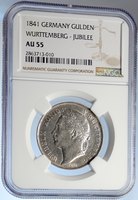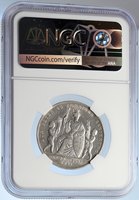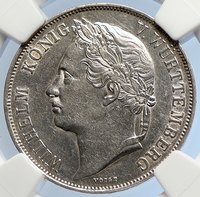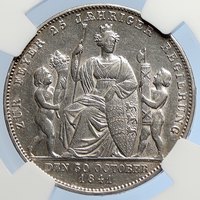Germany - German States - Kingdom of Wurttemberg Ruled by Wilhelm I - Emperor: 2 January 1861 – 9 March 1888
25th Anniversary of the Reign of King Wilhelm
1841 Silver Gulden 30mm (10.42 grams) 0.900 Silver (0.3067 oz. ASW)
Reference: KM# 588
Certification: NGC
AU 55 2863713-010
WILHELM KÖNIG V. WÜRTTEMBERG VOIGT, Head left.
ZUR FEYER 25 JAHRIGER REGIERUNG DEN 30 OCTOBER 1841, Seated figure flanked by child with cornucopia left and child with fasces right.
Edge Lettering: * EIN * GULDEN * You are bidding on the exact item pictured, provided with a Certificate of Authenticity and Lifetime Guarantee of Authenticity.
 The Kingdom of Württemberg (German: Königreich Württemberg; German pronunciation: [ˌkøːnɪkʁaɪç ˈvʏʁtəmbɛʁk]) was a German state that existed from 1805 to 1918, located within the area that is now Baden-Württemberg. The kingdom was a continuation of the Duchy of Württemberg, which existed from 1495 to 1805. Prior to 1495, Württemberg was a County in the former Duchy of Swabia, which had dissolved after the death of Duke Conradin in 1268. The Kingdom of Württemberg (German: Königreich Württemberg; German pronunciation: [ˌkøːnɪkʁaɪç ˈvʏʁtəmbɛʁk]) was a German state that existed from 1805 to 1918, located within the area that is now Baden-Württemberg. The kingdom was a continuation of the Duchy of Württemberg, which existed from 1495 to 1805. Prior to 1495, Württemberg was a County in the former Duchy of Swabia, which had dissolved after the death of Duke Conradin in 1268.
The borders of the Kingdom of Württemberg, as defined in 1813, lay between 47°34' and 49°35' north and 8°15' and 10°30' east. The greatest distance north to south comprised 225 kilometres (140 mi) and the greatest east to west was 160 kilometres (99 mi). The border had a total length of 1,800 kilometres (1,100 mi) and the total area of the state was 19,508 square kilometres (7,532 sq mi).  The kingdom had borders with Bavaria on the east and south, with Baden in the north, west and south. The southern part surrounded the Prussian province of Hohenzollern on most of its sides and touched on Lake Constance. The kingdom had borders with Bavaria on the east and south, with Baden in the north, west and south. The southern part surrounded the Prussian province of Hohenzollern on most of its sides and touched on Lake Constance.
Frederick II, the Duke of Württemberg, assumed the title of King Frederick I on 1 January 1806. He abrogated the constitution, and united Old and New Württemberg. Subsequently, he placed the property of the church under government control, and greatly extended the borders of the kingdom by the process of mediatisation. .svg/250px-German_Empire_-_Wurttemberg_(1871).svg.png) In 1806, Frederick joined the Confederation of the Rhine and received further territory with 160,000 inhabitants. Later, by the Peace of Vienna of October 1809, about 110,000 more people came under his rule. In return for these favours, Frederick joined French Emperor Napoleon in his campaigns against Prussia, Austria and Russia. Of the 16,000 of his subjects who marched to Moscow, only a few hundred returned. After the Battle of Leipzig in October 1813, Frederick deserted the French emperor and, by a treaty with Metternich at Fulda in November 1813, he secured the confirmation of his royal title and of his recent acquisitions of territory. Meanwhile, his troops marched into France with the allies. In 1815, the King joined the German Confederation but the Congress of Vienna made no change to the extent of his lands. In the same year, he laid before the representatives of his people the outline of a new constitution but they rejected it and, in the midst of the commotion that ensued, Frederick died on 30 October 1816. In 1806, Frederick joined the Confederation of the Rhine and received further territory with 160,000 inhabitants. Later, by the Peace of Vienna of October 1809, about 110,000 more people came under his rule. In return for these favours, Frederick joined French Emperor Napoleon in his campaigns against Prussia, Austria and Russia. Of the 16,000 of his subjects who marched to Moscow, only a few hundred returned. After the Battle of Leipzig in October 1813, Frederick deserted the French emperor and, by a treaty with Metternich at Fulda in November 1813, he secured the confirmation of his royal title and of his recent acquisitions of territory. Meanwhile, his troops marched into France with the allies. In 1815, the King joined the German Confederation but the Congress of Vienna made no change to the extent of his lands. In the same year, he laid before the representatives of his people the outline of a new constitution but they rejected it and, in the midst of the commotion that ensued, Frederick died on 30 October 1816.
William IFrederick was succeeded by his son, William I who, after much discussion, granted a new constitution in September 1819. This constitution (with subsequent modifications) remained in force until 1918 (see Württemberg). The desire for greater political freedom did not entirely fade under the constitution of 1819 and, after 1830, some transitory unrest occurred. A period of quiet set in and the condition of the kingdom, its education, its agriculture, its trade and economy improved. Both in public and in private matters, William's frugality helped to repair the country's shattered finances. The inclusion of Württemberg in the German Zollverein and the construction of railways fostered trade. The revolutionary movement of 1848 did not leave Württemberg untouched, although no violence took place in the territory. William had to dismiss Johannes Schlayer (1792-1860) and his other ministers, and appoint men with more liberal ideas, proponents of a united Germany. William proclaimed a democratic constitution but, as soon as the movement had spent its force, he dismissed the liberal ministers and, in October 1849, Schlayer and his associates returned to power. In 1851, by interfering with popular electoral rights, the King and his ministers succeeded in assembling a servile diet that surrendered the privileges gained since 1848. In this way the authorities restored the constitution of 1819 and power passed into bureaucratic hands. A concordat with the papacy proved almost the last act of William's long reign, but the diet repudiated the agreement.
 William I, also known as Wilhelm I (full name: William Frederick Louis, German: Wilhelm Friedrich Ludwig, 22 March 1797 - 9 March 1888), of the House of Hohenzollern was the King of Prussia (2 January 1861 - 9 March 1888) and the first German Emperor (18 January 1871 - 9 March 1888), as well as the first Head of State of a united Germany. Under the leadership of William and his Minister President Otto von Bismarck, Prussia achieved the unification of Germany and the establishment of the German Empire. Despite his long support of Otto von Bismarck as Minister President, however, William held strong reservations about some of Bismarck's more reactionary policies, including his anti-Catholicism and tough handling of subordinates. Contrary to the aggressive, domineering Bismarck, William was described as polite, gentlemanly, and while a staunch conservative, more open to certain classical liberal ideas than his grandson Wilhelm II. William I, also known as Wilhelm I (full name: William Frederick Louis, German: Wilhelm Friedrich Ludwig, 22 March 1797 - 9 March 1888), of the House of Hohenzollern was the King of Prussia (2 January 1861 - 9 March 1888) and the first German Emperor (18 January 1871 - 9 March 1888), as well as the first Head of State of a united Germany. Under the leadership of William and his Minister President Otto von Bismarck, Prussia achieved the unification of Germany and the establishment of the German Empire. Despite his long support of Otto von Bismarck as Minister President, however, William held strong reservations about some of Bismarck's more reactionary policies, including his anti-Catholicism and tough handling of subordinates. Contrary to the aggressive, domineering Bismarck, William was described as polite, gentlemanly, and while a staunch conservative, more open to certain classical liberal ideas than his grandson Wilhelm II.
 Germany, officially the Federal Republic of Germany, officially the Federal Republic of  Germany is a federal parliamentary republic in western-central Europe. It includes 16 constituent states and covers an area of 357,021 square kilometres (137,847 sq mi) with a largely temperate seasonal climate. Its capital and largest city is Berlin. With 81 million inhabitants, Germany is the most populous member state in the European Union. After the United States, it is the second most popular migration destination in the world. Germany is a federal parliamentary republic in western-central Europe. It includes 16 constituent states and covers an area of 357,021 square kilometres (137,847 sq mi) with a largely temperate seasonal climate. Its capital and largest city is Berlin. With 81 million inhabitants, Germany is the most populous member state in the European Union. After the United States, it is the second most popular migration destination in the world.
Various Germanic tribes have occupied northern Germany since classical antiquity. A region named Germania was documented before 100 CE. During the Migration Period the Germanic tribes expanded southward. Beginning in the 10th century, German territories formed a central part of the Holy Roman Empire. During the 16th century, northern German regions became the centre of the Protestant Reformation. The rise of Pan-Germanism inside the German Confederation resulted in the unification of most of the German states in 1871 into the Prussian-dominated German Empire. After World War I and the German Revolution of 1918-1919, the Empire was replaced by the parliamentary Weimar Republic. The establishment of the Third Reich in 1933 led to World War II and the Holocaust. After 1945, Germany split into two states, East Germany and West Germany. In 1990, the country was reunified.  In the 21st century, Germany is a great power and has the world's fourth-largest economy by nominal GDP, as well as the fifth-largest by PPP. As a global leader in several industrial and technological sectors, it is both the world's third-largest exporter and importer of goods. Germany is a developed country with a very high standard of living sustained by a skilled and productive society. It upholds a social security and universal health care system, environmental protection and a tuition free university education. In the 21st century, Germany is a great power and has the world's fourth-largest economy by nominal GDP, as well as the fifth-largest by PPP. As a global leader in several industrial and technological sectors, it is both the world's third-largest exporter and importer of goods. Germany is a developed country with a very high standard of living sustained by a skilled and productive society. It upholds a social security and universal health care system, environmental protection and a tuition free university education.
Germany was a founding member of the European Union in 1993. It is part of the Schengen Area, and became a co-founder of the Eurozone in 1999. Germany is a member of the United Nations, NATO, the G8, the G20, and the OECD. The national military expenditure is the 9th highest in the world. Known for its rich cultural history, Germany has been continuously the home of influential artists, philosophers, musicians, sportsmen, entrepreneurs, scientists and inventors.
|




 The Kingdom of Württemberg (German: Königreich Württemberg; German pronunciation: [ˌkøːnɪkʁaɪç ˈvʏʁtəmbɛʁk]) was a German state that existed from 1805 to 1918, located within the area that is now Baden-Württemberg. The kingdom was a continuation of the Duchy of Württemberg, which existed from 1495 to 1805. Prior to 1495, Württemberg was a County in the former Duchy of Swabia, which had dissolved after the death of Duke Conradin in 1268.
The Kingdom of Württemberg (German: Königreich Württemberg; German pronunciation: [ˌkøːnɪkʁaɪç ˈvʏʁtəmbɛʁk]) was a German state that existed from 1805 to 1918, located within the area that is now Baden-Württemberg. The kingdom was a continuation of the Duchy of Württemberg, which existed from 1495 to 1805. Prior to 1495, Württemberg was a County in the former Duchy of Swabia, which had dissolved after the death of Duke Conradin in 1268.  The kingdom had borders with Bavaria on the east and south, with Baden in the north, west and south. The southern part surrounded the Prussian province of Hohenzollern on most of its sides and touched on Lake Constance.
The kingdom had borders with Bavaria on the east and south, with Baden in the north, west and south. The southern part surrounded the Prussian province of Hohenzollern on most of its sides and touched on Lake Constance. .svg/250px-German_Empire_-_Wurttemberg_(1871).svg.png) In 1806, Frederick joined the Confederation of the Rhine and received further territory with 160,000 inhabitants. Later, by the Peace of Vienna of October 1809, about 110,000 more people came under his rule. In return for these favours, Frederick joined French Emperor Napoleon in his campaigns against Prussia, Austria and Russia. Of the 16,000 of his subjects who marched to Moscow, only a few hundred returned. After the Battle of Leipzig in October 1813, Frederick deserted the French emperor and, by a treaty with Metternich at Fulda in November 1813, he secured the confirmation of his royal title and of his recent acquisitions of territory. Meanwhile, his troops marched into France with the allies. In 1815, the King joined the German Confederation but the Congress of Vienna made no change to the extent of his lands. In the same year, he laid before the representatives of his people the outline of a new constitution but they rejected it and, in the midst of the commotion that ensued, Frederick died on 30 October 1816.
In 1806, Frederick joined the Confederation of the Rhine and received further territory with 160,000 inhabitants. Later, by the Peace of Vienna of October 1809, about 110,000 more people came under his rule. In return for these favours, Frederick joined French Emperor Napoleon in his campaigns against Prussia, Austria and Russia. Of the 16,000 of his subjects who marched to Moscow, only a few hundred returned. After the Battle of Leipzig in October 1813, Frederick deserted the French emperor and, by a treaty with Metternich at Fulda in November 1813, he secured the confirmation of his royal title and of his recent acquisitions of territory. Meanwhile, his troops marched into France with the allies. In 1815, the King joined the German Confederation but the Congress of Vienna made no change to the extent of his lands. In the same year, he laid before the representatives of his people the outline of a new constitution but they rejected it and, in the midst of the commotion that ensued, Frederick died on 30 October 1816.  William I, also known as Wilhelm I (full name: William Frederick Louis, German: Wilhelm Friedrich Ludwig, 22 March 1797 - 9 March 1888), of the House of Hohenzollern was the King of Prussia (2 January 1861 - 9 March 1888) and the first German Emperor (18 January 1871 - 9 March 1888), as well as the first Head of State of a united Germany. Under the leadership of William and his Minister President Otto von Bismarck, Prussia achieved the unification of Germany and the establishment of the German Empire. Despite his long support of Otto von Bismarck as Minister President, however, William held strong reservations about some of Bismarck's more reactionary policies, including his anti-Catholicism and tough handling of subordinates. Contrary to the aggressive, domineering Bismarck, William was described as polite, gentlemanly, and while a staunch conservative, more open to certain classical liberal ideas than his grandson Wilhelm II.
William I, also known as Wilhelm I (full name: William Frederick Louis, German: Wilhelm Friedrich Ludwig, 22 March 1797 - 9 March 1888), of the House of Hohenzollern was the King of Prussia (2 January 1861 - 9 March 1888) and the first German Emperor (18 January 1871 - 9 March 1888), as well as the first Head of State of a united Germany. Under the leadership of William and his Minister President Otto von Bismarck, Prussia achieved the unification of Germany and the establishment of the German Empire. Despite his long support of Otto von Bismarck as Minister President, however, William held strong reservations about some of Bismarck's more reactionary policies, including his anti-Catholicism and tough handling of subordinates. Contrary to the aggressive, domineering Bismarck, William was described as polite, gentlemanly, and while a staunch conservative, more open to certain classical liberal ideas than his grandson Wilhelm II. Germany, officially the Federal Republic of
Germany, officially the Federal Republic of  Germany is a federal parliamentary republic in western-central Europe. It includes 16 constituent states and covers an area of 357,021 square kilometres (137,847 sq mi) with a largely temperate seasonal climate. Its capital and largest city is Berlin. With 81 million inhabitants, Germany is the most populous member state in the European Union. After the United States, it is the second most popular migration destination in the world.
Germany is a federal parliamentary republic in western-central Europe. It includes 16 constituent states and covers an area of 357,021 square kilometres (137,847 sq mi) with a largely temperate seasonal climate. Its capital and largest city is Berlin. With 81 million inhabitants, Germany is the most populous member state in the European Union. After the United States, it is the second most popular migration destination in the world. In the 21st century, Germany is a great power and has the world's fourth-largest economy by nominal GDP, as well as the fifth-largest by PPP. As a global leader in several industrial and technological sectors, it is both the world's third-largest exporter and importer of goods. Germany is a developed country with a very high standard of living sustained by a skilled and productive society. It upholds a social security and universal health care system, environmental protection and a tuition free university education.
In the 21st century, Germany is a great power and has the world's fourth-largest economy by nominal GDP, as well as the fifth-largest by PPP. As a global leader in several industrial and technological sectors, it is both the world's third-largest exporter and importer of goods. Germany is a developed country with a very high standard of living sustained by a skilled and productive society. It upholds a social security and universal health care system, environmental protection and a tuition free university education.
